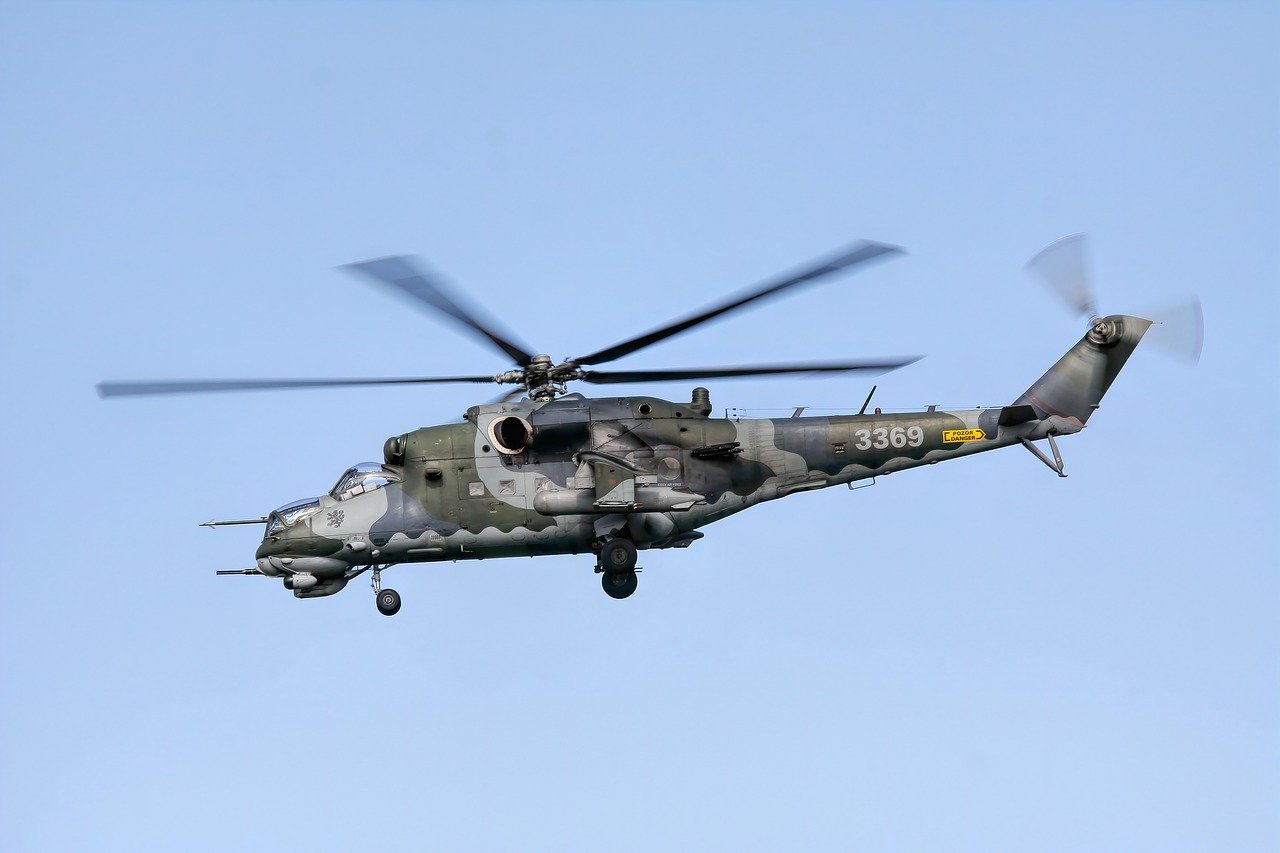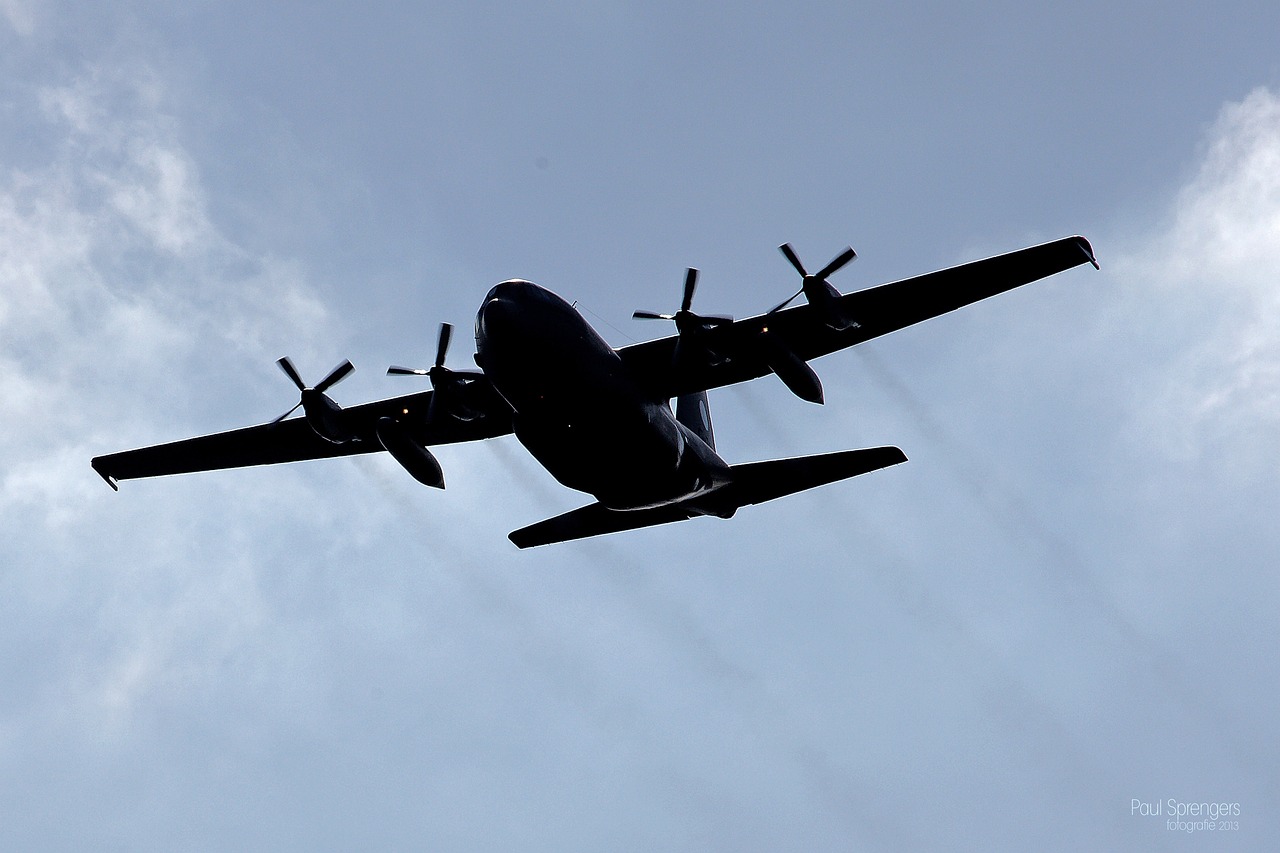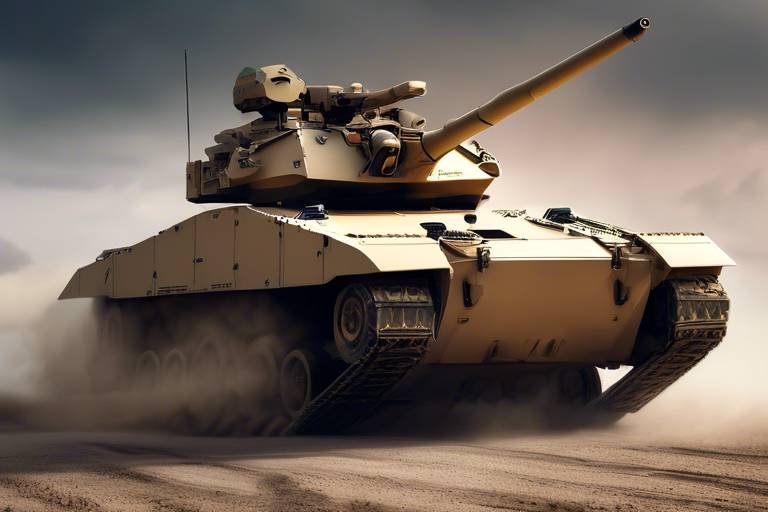AI-Powered Tactical Support for Ground Combat
In the ever-evolving landscape of military operations, the integration of artificial intelligence (AI) into ground combat is nothing short of revolutionary. Imagine a battlefield where decisions are made not just by human intuition but also by advanced algorithms analyzing data in real-time. This is not science fiction; it's the reality of modern warfare. AI is transforming how military forces operate, providing tactical support that enhances the effectiveness and efficiency of ground troops. From improving situational awareness to enabling autonomous vehicles, AI is reshaping the way we think about combat.
One of the most significant advantages of AI in ground combat is its ability to process vast amounts of information quickly. In traditional warfare, commanders often relied on their instincts and limited information to make critical decisions. Now, with AI, they can access a wealth of data from various sources, including satellite imagery, drone surveillance, and on-ground sensors. This data is analyzed in real-time, allowing for a comprehensive understanding of the battlefield, enemy movements, and potential threats. As a result, military strategies can be adjusted on the fly, leading to more successful mission outcomes.
Moreover, AI enhances communication and coordination among ground units. In the chaos of combat, ensuring that all team members are on the same page is crucial. AI systems streamline information sharing, allowing for seamless communication between units. This not only improves operational efficiency but also fosters a sense of unity among troops, which is essential for mission success. Imagine a scenario where every soldier has access to the same real-time data, enabling them to act cohesively rather than as isolated units. This level of integration can mean the difference between victory and defeat.
As we delve deeper into the applications of AI in ground combat, it's essential to recognize the challenges and ethical considerations that come with this technology. While AI offers numerous advantages, it also raises questions about accountability and decision-making authority. Who is responsible when an AI system makes a critical error in judgment? These are complex issues that military leaders must grapple with as they integrate AI into their operations.
Looking to the future, the potential of AI in ground combat is vast. Ongoing research and development are focused on harnessing AI's capabilities while addressing the associated risks. As we stand on the brink of this new era in military operations, one thing is clear: AI is not just a tool; it’s a game-changer that will redefine how we approach warfare.
- What are the primary benefits of using AI in ground combat?
AI enhances situational awareness, improves decision-making, and streamlines communication among troops, leading to more effective military operations. - How does AI improve situational awareness?
AI analyzes data from various sources in real-time, providing commanders with a comprehensive understanding of the battlefield and enemy movements. - What ethical concerns are associated with AI in military operations?
Key concerns include accountability for AI decisions, potential misuse of technology, and the implications of autonomous systems in combat. - What is the future of AI in ground combat?
The future promises continued advancements in AI technology, reshaping military tactics and strategies while addressing ethical and operational challenges.

Understanding AI in Military Operations
This article explores the integration of artificial intelligence in ground combat, highlighting its benefits, applications, and future implications for military operations and decision-making processes on the battlefield.
Artificial Intelligence (AI) is not just a buzzword; it’s a revolutionary force reshaping how military operations are conducted. Imagine a battlefield where decisions are made not just by human intuition but by advanced algorithms analyzing real-time data. Sounds futuristic, right? Well, that future is here. The integration of AI in military operations is fundamentally transforming traditional combat strategies, making them more efficient and effective.
At its core, AI in military operations encompasses a range of technologies that enable machines to perform tasks that typically require human intelligence. This includes everything from data analysis to decision-making and even autonomous operations. The impact of AI is profound: it allows for quicker response times, enhanced situational awareness, and improved resource allocation. In essence, AI acts as a force multiplier, augmenting the capabilities of human operators.
Let’s break down some of the key areas where AI is making waves in military settings:
- Data Processing: AI can sift through massive amounts of data at lightning speed. This capability is crucial for military leaders who need to make informed decisions based on the latest intelligence.
- Operational Efficiency: By automating routine tasks, AI frees up human personnel to focus on more strategic aspects of military operations.
- Enhanced Decision-Making: AI algorithms can analyze patterns and predict outcomes, providing commanders with actionable insights that were previously unattainable.
One of the most significant advantages of AI in military operations is its ability to enhance situational awareness. With AI-driven systems, troops can receive real-time updates about their environment, enemy movements, and potential threats. This heightened awareness can mean the difference between success and failure in critical missions. For instance, AI can integrate data from various sources such as satellites, drones, and ground sensors to create a comprehensive picture of the battlefield.
Moreover, AI plays a pivotal role in predictive analytics. By analyzing historical data and current conditions, AI can forecast potential enemy actions, allowing military leaders to anticipate threats and adjust strategies proactively. This capability is akin to having a crystal ball, giving commanders a leg up in the chaotic environment of warfare.
However, the integration of AI in military operations is not without challenges. As we embrace these advanced technologies, it’s essential to consider the ethical implications and the need for robust oversight. Questions around accountability and the potential for misuse of AI systems are critical discussions that must accompany the technological advancements in military settings.
In summary, AI is not just enhancing military operations; it’s redefining them. The capabilities it brings to the table are vast and varied, promising to change the landscape of ground combat forever. As we continue to explore the potential of AI, it’s crucial to balance innovation with ethical considerations, ensuring that this powerful tool is used responsibly.
- What is AI's role in military operations?
AI enhances decision-making, situational awareness, and operational efficiency by analyzing data and predicting outcomes. - How does AI improve situational awareness?
AI integrates data from multiple sources, providing real-time updates and comprehensive battlefield insights. - What are the ethical concerns regarding AI in the military?
Key concerns include accountability for AI decisions and the potential for misuse of AI technologies.

Enhancing Situational Awareness
In the chaotic theater of ground combat, where every second counts and decisions can mean the difference between life and death, is paramount. This is where artificial intelligence (AI) steps in, revolutionizing the way ground troops perceive and interact with their environment. Imagine being in a dense forest, surrounded by the sounds of rustling leaves and distant gunfire. In such a scenario, having real-time access to a wealth of information can transform a soldier's ability to make informed decisions. AI technologies empower military personnel to analyze vast amounts of data swiftly, allowing for a clearer understanding of the battlefield landscape.
One of the most significant advantages of AI in enhancing situational awareness is its ability to process and interpret data from multiple sources almost instantaneously. For instance, AI systems can gather inputs from satellites, drones, ground sensors, and even social media feeds. By synthesizing this information, AI creates a comprehensive picture of the battlefield, illuminating enemy movements and potential threats. The speed at which AI can analyze this data can be likened to having a supercharged brain that never tires, constantly scanning for the next piece of critical information.
At the heart of AI's contribution to situational awareness lies its prowess in data collection and analysis. In modern warfare, data is generated at an unprecedented rate, and sifting through this information manually is a Herculean task. AI algorithms can extract relevant insights from the noise, providing commanders with actionable intelligence. For example, AI can analyze patterns in enemy behavior, allowing for predictive insights that can shape tactical decisions. This capability is akin to having a crystal ball, giving military leaders a glimpse into the future of the battlefield.
Moreover, AI excels in sensor integration, where it amalgamates data from various sensors, including aerial drones and ground reconnaissance units. This integration is crucial for creating a unified operational picture. Imagine a commander receiving inputs from multiple drones and ground troops simultaneously—this consolidated view enhances tactical planning and execution. With AI, the fog of war can be lifted, allowing for clearer strategies and a more cohesive response to threats.
Another fascinating aspect of AI in enhancing situational awareness is its use of predictive analytics. By analyzing historical data and current movements, AI can forecast potential enemy actions and outcomes. This predictive capability enables commanders to anticipate threats and adjust strategies proactively. Think of it as playing a game of chess where the AI not only understands the current position but can also predict the opponent's next several moves. With this foresight, military leaders can position their forces more effectively and deploy resources where they are needed most.
Effective communication and coordination among ground units are also significantly enhanced by AI. In the heat of battle, ensuring that all team members are on the same page is crucial. AI facilitates streamlined information sharing, allowing for real-time updates and situational reports. This capability is vital for maintaining unit cohesion and ensuring that everyone is informed of changing conditions on the ground. AI acts as the nervous system of military operations, transmitting crucial information quickly and efficiently.
In conclusion, the integration of AI into ground combat significantly enhances situational awareness, enabling troops to make better-informed decisions. With its capabilities in data collection, sensor integration, and predictive analytics, AI transforms the battlefield into a more manageable and comprehensible environment. As we continue to explore the potential of AI in military operations, the future of combat will undoubtedly be shaped by these advancements, leading to more effective and successful missions.
- What is situational awareness in military operations?
Situational awareness refers to the understanding of the environment and the ability to perceive, comprehend, and project the current state of the battlefield. - How does AI improve situational awareness?
AI improves situational awareness by processing vast amounts of data quickly, integrating information from multiple sensors, and providing predictive analytics to anticipate enemy actions. - What are the ethical considerations of using AI in combat?
Ethical considerations include accountability for AI decisions, potential misuse of technology, and the implications of autonomous decision-making in life-and-death situations.

Data Collection and Analysis
In the fast-paced world of ground combat, are no longer just supplementary tasks; they have become the backbone of effective military operations. Imagine being on the battlefield, surrounded by chaos, and having the ability to access real-time information that can change the course of a mission. This is where artificial intelligence (AI) steps in, transforming how military forces gather and interpret data. By utilizing advanced algorithms and machine learning techniques, AI systems can process vast amounts of information from various sources, providing commanders with a clearer understanding of the battlefield environment.
One of the most significant advantages of AI in data collection is its ability to synthesize information from multiple inputs, such as satellite imagery, drone reconnaissance, and ground sensors. This integration allows for a comprehensive overview of enemy movements and terrain conditions, enabling military leaders to make informed decisions swiftly. For instance, consider a scenario where a unit is advancing toward an enemy stronghold. With AI analyzing data from drones overhead and sensors embedded in the environment, commanders can receive real-time updates on enemy troop positions, potential ambush sites, and even weather conditions that could impact their strategy.
Moreover, AI-powered systems excel in predictive analytics, using historical data and current battlefield information to forecast enemy actions. By analyzing patterns and behaviors, AI can suggest likely enemy maneuvers, allowing commanders to anticipate threats before they materialize. This capability is akin to having a crystal ball that provides insights into the future, making it an invaluable asset in tactical planning. The combination of data collection and predictive analytics not only enhances situational awareness but also empowers ground troops to adapt their strategies on the fly.
However, it's essential to recognize that the effectiveness of AI in data collection hinges on the quality of the data being inputted. Garbage in, garbage out, as the saying goes. Therefore, ensuring that data sources are reliable and accurate is paramount. Military operations increasingly rely on sensor integration, where data from various sensors—be it thermal imaging, GPS, or audio surveillance—are collated and analyzed. The result is a multi-faceted view of the battlefield that significantly enhances tactical planning and execution.
To illustrate the impact of AI on data collection and analysis, consider the following table that summarizes key capabilities:
| Capability | Description | Benefits |
|---|---|---|
| Real-time Data Processing | AI analyzes data as it is collected from various sources. | Immediate insights for decision-making. |
| Predictive Analytics | Forecasts enemy actions based on historical data. | Proactive strategies to counter threats. |
| Sensor Integration | Combines data from multiple sensors to create a comprehensive battlefield picture. | Enhanced situational awareness and tactical planning. |
In conclusion, the integration of AI in data collection and analysis is revolutionizing ground combat operations. By providing real-time insights, predictive capabilities, and a holistic view of the battlefield, AI empowers military leaders to make informed decisions that can ultimately save lives and ensure mission success. As technology continues to evolve, the potential for AI to further enhance data analysis in military settings is boundless.
- How does AI improve decision-making in military operations? AI enhances decision-making by providing real-time data analysis, predictive insights, and a comprehensive understanding of the battlefield, allowing commanders to make informed choices quickly.
- What types of data can AI analyze in combat scenarios? AI can analyze data from various sources, including satellite imagery, drone feeds, ground sensors, and historical military data, to provide actionable insights.
- Are there ethical concerns regarding the use of AI in military operations? Yes, there are significant ethical considerations, including accountability for AI decisions, the potential for misuse, and the implications of autonomous systems in combat.

Sensor Integration
In the modern battlefield, the ability to integrate various sensor technologies is a game-changer. Imagine a scenario where ground troops are not just relying on their own eyes and ears, but are equipped with an entire network of sensors that provide real-time data about their surroundings. This is where comes into play, combining data from different sources such as drones, satellites, and ground-based sensors to create a comprehensive operational picture. This multifaceted approach allows commanders to make informed decisions quickly, enhancing tactical planning and execution.
For instance, consider a situation where a squad is advancing through a dense forest. Traditional methods might limit their understanding of what lies ahead. However, with integrated sensors, they can receive data from aerial drones that scout the area, thermal imaging sensors that detect hidden threats, and even GPS data that tracks friendly units' positions. This synergy of information transforms the way military operations are conducted, enabling a proactive rather than reactive strategy.
Moreover, the integration of sensors is not just about gathering data; it's about analyzing and interpreting that data effectively. Advanced AI algorithms can sift through vast amounts of information, filtering out noise and highlighting critical insights. This means that instead of being overwhelmed by data, commanders can focus on actionable intelligence that directly impacts mission success. In essence, sensor integration enhances situational awareness to a level previously thought impossible.
Let's take a closer look at some key components involved in sensor integration:
| Sensor Type | Functionality |
|---|---|
| Drones | Provide aerial reconnaissance and real-time surveillance. |
| Thermal Sensors | Detect heat signatures, useful for identifying hidden enemies. |
| Ground Sensors | Monitor ground movement and detect changes in the environment. |
| GPS Systems | Track the position of troops and vehicles on the battlefield. |
As we move forward, the integration of these technologies will only become more sophisticated. The future holds the promise of even more advanced sensors that can communicate seamlessly, providing a holistic view of the battlefield. This will not only improve operational efficiency but also significantly reduce the risks faced by ground troops. In conclusion, sensor integration is paving the way for a new era of tactical support in ground combat, where information is power, and the ability to harness it effectively can mean the difference between success and failure on the battlefield.
- What is sensor integration in military operations?
Sensor integration refers to the process of combining data from various types of sensors—such as drones, thermal imaging devices, and ground sensors—to create a comprehensive view of the battlefield, enhancing situational awareness and decision-making.
- How does AI enhance sensor integration?
AI enhances sensor integration by analyzing vast amounts of data in real-time, filtering out irrelevant information, and providing actionable insights that help commanders make informed decisions quickly.
- What are the benefits of using integrated sensors?
The benefits include improved situational awareness, faster decision-making, reduced risks for troops, and more effective tactical planning, ultimately leading to better mission outcomes.

Predictive Analytics
In the fast-paced world of military operations, the ability to anticipate enemy actions can mean the difference between victory and defeat. harnesses the power of artificial intelligence to analyze historical data, identify patterns, and forecast future events on the battlefield. This technology acts like a crystal ball for military strategists, providing insights that were previously unimaginable. Imagine having the capability to predict not just where an enemy might strike, but also how they might deploy their resources. This is where AI shines, turning raw data into actionable intelligence.
At its core, predictive analytics involves the collection and processing of vast amounts of information, including troop movements, weather conditions, and even social media activity in the region. By employing complex algorithms, military analysts can sift through this data to uncover trends and make educated guesses about potential enemy maneuvers. For example, if a particular unit has a history of launching attacks at dawn, predictive analytics can alert commanders to be on high alert during those hours, allowing for better-prepared defenses.
Moreover, predictive analytics doesn't just stop at forecasting enemy actions; it also plays a crucial role in resource allocation. By predicting where and when engagements are likely to occur, military leaders can ensure that troops and supplies are positioned optimally. This proactive approach minimizes the risk of being caught off guard and enhances the overall effectiveness of military operations.
To illustrate the impact of predictive analytics on military strategy, consider the following table that summarizes its key benefits:
| Benefit | Description |
|---|---|
| Enhanced Decision-Making | Provides commanders with timely insights to make informed choices. |
| Resource Optimization | Ensures troops and supplies are deployed where they are most needed. |
| Risk Mitigation | Helps identify potential threats before they materialize. |
| Improved Tactical Planning | Allows for the development of strategies based on anticipated enemy behavior. |
However, while the benefits of predictive analytics are clear, it is essential to recognize that this technology is not infallible. The accuracy of predictions heavily depends on the quality of data and the algorithms used. False positives can lead to unnecessary mobilization of forces, wasting resources and potentially causing panic. Therefore, military leaders must approach predictive analytics with a balanced perspective, combining it with human intuition and experience to make the best decisions.
In summary, predictive analytics represents a significant advancement in military strategy, offering a glimpse into the future of warfare. As AI continues to evolve, its ability to predict enemy actions and optimize military operations will only improve, making it an indispensable tool for ground combat units.
- What is predictive analytics in military operations? Predictive analytics involves using AI to analyze data and forecast future enemy actions, enhancing decision-making and strategic planning.
- How does predictive analytics improve military effectiveness? By providing timely insights and optimizing resource allocation, predictive analytics helps military leaders prepare for potential threats and execute more effective operations.
- What are the limitations of predictive analytics? The accuracy of predictions depends on data quality and algorithms, and there is a risk of false positives leading to unnecessary mobilization of forces.
- Will predictive analytics replace human decision-making? No, it is meant to complement human intuition and experience, ensuring that decisions are well-informed and balanced.

Communication and Coordination
In the chaotic environment of ground combat, where every second counts, effective communication and coordination can be the difference between mission success and failure. Imagine a well-oiled machine, where each part works in perfect harmony; that’s the goal for military units on the battlefield. With the integration of artificial intelligence, this ideal is becoming a reality. AI technologies streamline information sharing, ensuring that all team members are aligned and aware of the evolving situation around them.
AI systems can facilitate real-time communication channels that allow troops to exchange critical information swiftly. For instance, when a squad encounters unexpected enemy movement, they can instantly relay this data to command centers and other units, enabling a rapid response. This capability not only enhances situational awareness but also fosters a culture of collaboration among ground troops. Imagine a scenario where every soldier is equipped with AI-driven communication devices that analyze incoming data, prioritize messages, and suggest optimal responses. This is not just a futuristic dream; it’s increasingly becoming a part of modern military operations.
Another significant advantage of AI in communication is its ability to filter and analyze vast amounts of information. Traditional communication methods can become overwhelmed with data, leading to confusion and delays. However, AI can process this information, highlighting the most pertinent details and presenting them in a digestible format. For example, during a mission, AI can prioritize alerts based on threat levels, ensuring that soldiers receive the most critical information first. This can be crucial in high-stakes situations where every second matters.
Moreover, AI-enhanced coordination tools can assist in tactical planning by providing commanders with a comprehensive overview of troop movements and enemy positions. By integrating data from various sources, such as drones, ground sensors, and reconnaissance units, AI can create a cohesive operational picture. This allows commanders to make informed decisions quickly and allocate resources effectively. The result? A more agile and responsive military force capable of adapting to rapidly changing conditions on the battlefield.
However, with these advancements come challenges. As AI takes on more communication and coordination responsibilities, it raises questions about reliability and trust. What happens if the AI misinterprets data or fails to communicate critical information? This is where rigorous training and testing of AI systems come into play, ensuring that they can handle the complexities of real-world combat scenarios.
In conclusion, the role of AI in enhancing communication and coordination among ground troops cannot be overstated. As military operations continue to evolve, the integration of AI technologies promises to create a more connected, informed, and efficient fighting force. The future of ground combat is not just about advanced weaponry; it’s also about how well units can communicate and coordinate in the heat of battle.
- How does AI improve communication in military operations?
AI enhances communication by providing real-time data analysis, prioritizing messages, and ensuring that critical information is shared swiftly among troops. - What are the risks associated with AI in military communication?
Potential risks include misinterpretation of data, communication failures, and over-reliance on technology, which can lead to vulnerabilities on the battlefield. - Can AI systems operate independently in combat scenarios?
While AI can assist in decision-making and communication, human oversight remains crucial to ensure accountability and ethical considerations in combat situations.

Autonomous Vehicles and Drones
The battlefield of the future is rapidly transforming, and at the forefront of this revolution are autonomous vehicles and drones. These advanced technologies are not just enhancing ground combat; they are redefining it. Imagine a scenario where troops can focus more on strategy and less on logistics, all thanks to AI-powered machines that can navigate complex terrains and deliver supplies without human intervention. This is not science fiction; it's the reality of modern warfare.
One of the most significant advantages of using autonomous vehicles in military operations is their ability to conduct logistical support seamlessly. These vehicles can transport essential supplies, ammunition, and equipment to troops stationed in remote or dangerous areas. By optimizing supply routes and managing inventory efficiently, AI-driven logistics systems ensure that soldiers have what they need, when they need it. This not only boosts morale but also enhances mission success rates. According to recent studies, units utilizing autonomous logistics have reported a 30% increase in operational efficiency.
Moreover, combat drones are taking on a pivotal role in ground operations. Equipped with sophisticated AI, these drones can engage targets with unparalleled precision. Unlike traditional air support, which often involves manned aircraft, combat drones can operate in high-risk areas without putting pilots' lives on the line. This capability not only minimizes collateral damage but also allows for more strategic engagement with enemy forces. Picture a drone that can assess a target, determine the best approach, and execute a strike—all while relaying real-time data back to commanders on the ground. This level of integration enhances situational awareness and allows for swift tactical adjustments.
However, the integration of autonomous vehicles and drones into military operations is not without its challenges. Issues such as communication between human operators and machines, the reliability of AI decision-making, and the potential for technical failures must be addressed. The military is investing heavily in research and development to ensure these systems can operate effectively in dynamic environments. As these technologies evolve, they will likely become even more sophisticated, capable of making real-time decisions that could save lives and enhance mission outcomes.
In summary, the incorporation of autonomous vehicles and drones into ground combat operations represents a significant leap forward in military capabilities. These technologies not only streamline logistics and enhance combat effectiveness but also reduce risks to personnel. As we look to the future, the potential applications of AI in this domain are boundless, promising a new era of warfare that prioritizes efficiency, safety, and strategic superiority.
- What are autonomous vehicles in military operations?
Autonomous vehicles are unmanned machines that can perform tasks such as transporting supplies and conducting reconnaissance without human intervention. - How do drones improve ground combat?
Drones provide real-time intelligence, engage targets with precision, and reduce the risk to human pilots, enhancing overall mission effectiveness. - What challenges do autonomous systems face in combat?
Challenges include communication issues, reliability of AI decision-making, and technical failures, which are being addressed through ongoing research and development.

Logistical Support
In the ever-evolving landscape of modern warfare, plays a pivotal role in ensuring the success of military operations. With the integration of artificial intelligence (AI), the logistics of ground combat are being transformed in ways that were previously unimaginable. Imagine a battlefield where supplies are delivered just in time, where resources are managed with pinpoint accuracy, and where troops are never left wanting for essential equipment. This is the reality that AI is helping to create.
One of the most significant advantages of AI in logistical support is its ability to optimize supply chains. By analyzing real-time data, AI systems can determine the fastest and most efficient routes for transporting supplies. For instance, if a unit is engaged in a prolonged skirmish, AI can reroute supply convoys to avoid enemy fire, ensuring that troops receive the necessary ammunition and provisions without delay. This kind of adaptability is crucial in high-stakes environments where every second counts.
Moreover, AI can manage inventory levels with impressive accuracy. Traditional methods often rely on manual counting and estimation, which can lead to either shortages or excesses. With AI, military logistics can be streamlined through predictive modeling. For example, if a unit is expected to engage in a longer conflict, the AI can forecast the needed supplies based on historical data and current consumption rates. This ensures that resources are allocated efficiently, reducing waste and enhancing overall mission effectiveness.
To illustrate the impact of AI on logistical support, consider the following table that outlines key benefits:
| Benefit | Description |
|---|---|
| Real-Time Data Analysis | AI systems analyze data from various sources to optimize supply routes and minimize delays. |
| Predictive Inventory Management | AI forecasts supply needs based on historical data, ensuring troops have the right resources at the right time. |
| Enhanced Decision-Making | AI provides commanders with actionable insights, allowing for quicker and more informed logistical decisions. |
Furthermore, AI technology can also assist in maintenance scheduling for vehicles and equipment. By monitoring usage patterns and wear-and-tear, AI can predict when maintenance is due, thereby preventing equipment failures that could jeopardize missions. This proactive approach not only enhances the readiness of military assets but also extends their lifespan, ultimately saving costs in the long run.
In conclusion, the integration of AI into logistical support represents a paradigm shift in military operations. As we continue to explore the capabilities of AI, it becomes increasingly clear that its role is not just supplementary but essential. By optimizing supply routes, managing inventory, and enhancing decision-making processes, AI is ensuring that ground troops are well-equipped and prepared for the challenges they face on the battlefield.
- How does AI optimize supply routes in military logistics?
AI analyzes real-time data, predicting the safest and fastest routes for supply convoys, thus minimizing delays and risks. - What role does predictive inventory management play in military operations?
It forecasts supply needs based on historical data, ensuring that troops have the necessary resources without overstocking. - Can AI help prevent equipment failures in the field?
Yes, AI monitors equipment usage and predicts maintenance needs, preventing failures that could hinder operations.

Combat Drones
In the realm of modern warfare, have emerged as game-changers, redefining how military operations are conducted on the ground. These unmanned aerial vehicles (UAVs) are not just flying machines; they are sophisticated systems equipped with advanced AI technologies that enable them to perform a variety of tasks with remarkable precision. Imagine a hawk soaring high above the battlefield, its keen eyes spotting targets while staying out of harm's way. That's the essence of what combat drones bring to the table.
One of the most significant advantages of using combat drones is their ability to engage targets with an accuracy that minimizes collateral damage. Traditional air support often involves manned aircraft that can inadvertently cause civilian casualties or damage to infrastructure. In contrast, drones can be programmed to identify specific targets based on real-time intelligence, allowing for pinpoint strikes that focus solely on enemy combatants. This precision not only enhances the effectiveness of ground operations but also helps maintain the moral high ground in military engagements.
Furthermore, combat drones can operate in environments that may be too dangerous for human pilots. For instance, in areas with heavy anti-aircraft defenses or amidst intense ground fire, deploying a manned aircraft could lead to catastrophic losses. Drones, however, can carry out reconnaissance missions or strike at targets without putting human lives at risk. This capability is particularly crucial in asymmetric warfare, where adversaries may employ unconventional tactics that require quick and decisive action.
To illustrate the impact of combat drones on ground operations, consider the following table that highlights their key functionalities:
| Functionality | Description |
|---|---|
| Reconnaissance | Gathering intelligence on enemy positions and movements through high-resolution cameras and sensors. |
| Target Engagement | Identifying and striking enemy targets with precision-guided munitions. |
| Real-time Data Transmission | Sending live video feeds and data back to commanders for situational awareness. |
| Logistics Support | Delivering supplies and equipment to troops in remote or hostile areas. |
Moreover, the integration of AI into combat drones allows for autonomous decision-making. These drones can analyze data from their surroundings and make real-time decisions about when to engage or withdraw from a target. However, this capability raises important questions about the ethics of automated warfare. As we rely more on machines to make critical decisions, we must consider the implications of removing human judgment from the battlefield.
In conclusion, combat drones represent a significant advancement in military technology, providing enhanced operational capabilities while reducing risks to human life. As the technology continues to evolve, we can expect even greater innovations that will shape the future of ground combat. The question remains: how will we navigate the ethical landscape that accompanies these powerful tools?
- What are combat drones used for?
Combat drones are primarily used for reconnaissance, target engagement, and logistics support in military operations. - How do combat drones minimize collateral damage?
They utilize advanced targeting systems and AI to identify and engage specific threats, reducing the risk of harming civilians or infrastructure. - Are combat drones fully autonomous?
While many combat drones have autonomous capabilities, they often operate under human supervision to ensure ethical decision-making. - What are the ethical concerns surrounding combat drones?
Key concerns include accountability for actions taken by drones, the potential for misuse, and the implications of removing human judgment from warfare.

Challenges and Ethical Considerations
The integration of artificial intelligence into ground combat operations is not without its challenges and ethical dilemmas. While the benefits of AI, such as enhanced efficiency and improved situational awareness, are clear, the implications of its use in military settings raise significant questions. One of the primary concerns is accountability. As AI systems increasingly take on decision-making roles, the question arises: who is responsible for the actions taken by these autonomous systems? This dilemma complicates traditional military ethics, where accountability has always been a cornerstone. If an autonomous drone mistakenly engages a civilian target, how do we assign blame? Is it the programmer, the military commander, or the AI itself? These questions remain largely unanswered and require urgent attention.
Another pressing issue is the potential for misuse of AI technologies. The risk of these advanced systems falling into the wrong hands poses a significant threat to global security. Imagine a scenario where a rogue state or non-state actors gain access to sophisticated AI-driven weaponry. The consequences could be catastrophic, leading to conflicts that could easily spiral out of control. To mitigate these risks, robust security measures and international regulations are imperative. Countries must collaborate to establish guidelines that govern the development and deployment of AI in military contexts, ensuring that these technologies are used responsibly.
Moreover, the ethical implications of using AI in combat extend beyond accountability and misuse. The very nature of warfare is changing, with machines making life-and-death decisions that were once the sole purview of human beings. This shift raises critical questions about the moral implications of delegating such power to algorithms. Can machines truly understand the complexities of human life and moral dilemmas? The fear is that as we increasingly rely on AI, we may inadvertently dehumanize warfare, treating combat as a mere calculation rather than a profound human experience.
To further illustrate these challenges, consider the following table that summarizes key ethical considerations:
| Ethical Consideration | Description |
|---|---|
| Accountability | Determining who is responsible for decisions made by autonomous systems. |
| Potential for Misuse | The risk of AI technologies being exploited by malicious actors. |
| Dehumanization of Warfare | Concerns about the moral implications of machines making life-and-death decisions. |
In conclusion, while the potential of AI in ground combat is immense, it is crucial to navigate these challenges with caution. As military operations evolve, so too must our understanding of the ethical landscape surrounding AI technologies. Engaging in open dialogues, conducting rigorous research, and establishing international protocols are essential steps toward ensuring that AI serves humanity rather than endangering it.
- What are the primary ethical concerns regarding AI in military operations?
The main concerns include accountability for autonomous decisions, the potential for misuse of AI technologies, and the moral implications of machines making life-and-death choices. - How can international regulations help mitigate risks associated with AI in combat?
By establishing guidelines for the development and deployment of AI technologies, countries can ensure responsible use and prevent these systems from falling into the wrong hands. - What is the impact of AI on traditional military ethics?
AI complicates traditional military ethics by introducing questions about accountability and the moral implications of delegating decision-making to machines.

Accountability in AI Decisions
The integration of artificial intelligence (AI) in military operations brings forth a host of benefits, but it also raises pressing questions about accountability. As AI systems become increasingly autonomous, the lines of responsibility blur, creating a complex web of ethical and operational challenges. Who is accountable when an AI system makes a decision that leads to unintended consequences? Is it the programmer, the military leadership, or the AI itself? These questions are not just academic; they have real-world implications on the battlefield.
One of the primary concerns is the concept of moral agency. Traditional military ethics have clear guidelines regarding who is responsible for actions taken during combat. However, with AI systems capable of making decisions without human intervention, the accountability framework becomes murky. Imagine a scenario where an autonomous drone misidentifies a target and engages civilians instead of enemy combatants. In such a case, pinpointing responsibility can be incredibly challenging. Is the blame on the developers who programmed the AI, the military officials who deployed it, or the system itself? This ambiguity can lead to a significant erosion of trust in military operations.
Furthermore, the decision-making authority of AI systems raises additional concerns. Should AI be allowed to make life-and-death decisions in combat situations? Many argue that human oversight is essential to ensure ethical standards are upheld. However, others contend that AI can process information and make decisions faster than humans, potentially leading to better outcomes in high-stakes situations. This dichotomy creates a tension between the desire for efficiency and the need for ethical accountability.
To address these issues, military organizations must establish clear guidelines and protocols surrounding the use of AI in combat. This includes:
- Transparent Algorithms: AI systems should operate on algorithms that are understandable and explainable, allowing for scrutiny and accountability.
- Human Oversight: Maintaining a human in the loop for critical decisions can help ensure that ethical considerations are taken into account.
- Regular Audits: Conducting regular audits of AI systems can help identify potential biases and ensure compliance with ethical standards.
Additionally, the international community must engage in discussions to create robust regulations governing the use of AI in military contexts. This includes establishing a framework that holds entities accountable for the deployment and actions of AI systems, thereby fostering a culture of responsibility and ethical conduct.
In conclusion, as we delve deeper into the realm of AI in military operations, it is vital to address the challenges surrounding accountability in AI decisions. By doing so, we can harness the potential of AI while ensuring that ethical standards are not only maintained but prioritized in the heat of battle.
- Who is responsible for decisions made by AI in military operations?
Accountability can be complex, involving programmers, military leaders, and the AI systems themselves. - What measures can be taken to ensure ethical AI use in combat?
Establishing transparent algorithms, maintaining human oversight, and conducting regular audits are essential measures. - Can AI systems operate independently in combat?
While AI can make decisions, many experts advocate for human oversight to ensure ethical considerations are met.

Potential for Misuse
The rapid advancement of AI technologies in military operations brings with it a double-edged sword. While the benefits of enhanced capabilities are undeniable, the poses significant risks that cannot be overlooked. Imagine a world where AI systems, designed to protect and serve, could also be manipulated to cause harm. This possibility raises profound questions about the ethical implications of deploying such powerful tools in combat scenarios.
One of the most pressing concerns is the risk of autonomous weapon systems being used irresponsibly or maliciously. Without stringent regulations and oversight, these systems could fall into the hands of rogue states or non-state actors, leading to a new era of warfare where accountability becomes murky. As AI systems become more sophisticated, the potential for unintended consequences grows exponentially. For instance, an AI-driven drone could misinterpret a civilian gathering as a military target, resulting in catastrophic outcomes.
Furthermore, the lack of transparency in AI decision-making processes complicates matters. It's not always clear how these systems arrive at their conclusions, which can create a dangerous environment where decisions are made based on algorithms that may not fully account for the complexities of human behavior or ethical considerations. This opacity can lead to a situation where commanders might rely too heavily on AI recommendations, potentially sidelining their own judgment and experience.
To mitigate these risks, it is essential to establish robust security measures and international regulations. This includes:
- Implementing strict guidelines for the development and deployment of AI technologies in military contexts.
- Conducting regular audits of AI systems to ensure compliance with ethical standards.
- Enhancing training for military personnel on the responsible use of AI, emphasizing the importance of maintaining human oversight.
Ultimately, the potential for misuse of AI in military operations cannot be ignored. As we forge ahead into an era dominated by technological advancements, it is imperative that we approach these innovations with caution and a strong ethical framework. The future of warfare may depend not only on the capabilities of AI but also on our ability to govern its use responsibly.
- What are the main risks associated with AI in military operations?
The main risks include potential misuse by unauthorized entities, lack of accountability in autonomous decision-making, and unintended consequences from AI actions. - How can we ensure ethical AI use in the military?
Establishing strict regulations, conducting regular audits, and providing comprehensive training for military personnel are crucial steps in ensuring ethical AI use. - What role does human oversight play in AI military systems?
Human oversight is essential to maintain accountability, ensure ethical considerations are addressed, and prevent reliance on AI systems that may misinterpret complex situations.

The Future of AI in Ground Combat
The future of AI in ground combat is not just a fleeting concept; it represents a profound transformation in how military operations are conducted. As we look ahead, we can anticipate that AI technologies will continue to evolve, leading to more sophisticated systems that enhance operational efficiency and effectiveness. Imagine a battlefield where decisions are made in real-time, powered by complex algorithms that analyze data faster than any human could. This is not science fiction; it's the trajectory of modern warfare.
One of the most exciting prospects is the integration of AI with advanced robotics. These robots could perform a variety of roles, from logistics to direct combat, thereby reducing the risk to human soldiers. For instance, envision a scenario where autonomous ground vehicles navigate treacherous terrains to deliver supplies or evacuate injured personnel without any human intervention. This level of efficiency could drastically change the dynamics of combat operations, allowing human soldiers to focus on strategy and coordination rather than mundane tasks.
Moreover, the use of AI in predictive analytics is set to revolutionize military planning. By analyzing patterns from previous conflicts and real-time data, AI can help commanders anticipate enemy movements and adjust strategies accordingly. This proactive approach could mean the difference between success and failure on the battlefield. For example, if a commander knows that an enemy is likely to flank their position based on historical data, they can preemptively reposition their forces to counteract that move.
However, with these advancements come significant challenges. The reliance on AI raises questions about human oversight and accountability. As AI systems become more autonomous, the military must grapple with who is responsible for decisions made by machines. Can we trust AI to make life-and-death choices without human intervention? These ethical dilemmas will require ongoing dialogue and the establishment of guidelines to ensure that technology serves humanity rather than undermines it.
Furthermore, the future landscape of ground combat will likely see a greater emphasis on collaboration between human and machine. Rather than replacing soldiers, AI will augment their capabilities, providing real-time insights and enhancing situational awareness. This synergy between human intuition and machine efficiency could lead to a new era of combat where both elements work together seamlessly. Imagine soldiers equipped with AI-driven exoskeletons, enhancing their physical strength and endurance while receiving real-time data feeds about the battlefield from advanced sensors.
As we delve deeper into this future, the importance of international regulations cannot be overstated. The potential for misuse of AI technologies in military applications poses a significant threat that transcends borders. Countries must collaborate to establish frameworks that govern the use of AI in combat, ensuring that these powerful tools are used ethically and responsibly. Without such measures, the risk of an arms race in AI technologies could lead to catastrophic consequences.
In conclusion, the future of AI in ground combat holds immense promise, but it also presents complex challenges that must be addressed. As military organizations continue to explore the capabilities of AI, the focus should be on creating systems that enhance human decision-making while maintaining ethical standards. The battlefield of tomorrow will not just be defined by the technology used but by the principles that govern its application.
- What role does AI play in enhancing military strategies?
AI helps analyze vast amounts of data, enabling military leaders to make informed decisions based on real-time insights. - Are there ethical concerns surrounding the use of AI in combat?
Yes, there are significant ethical dilemmas regarding accountability, decision-making authority, and the potential for misuse of AI technologies. - How will AI affect the role of human soldiers in the future?
AI is expected to augment human capabilities, allowing soldiers to focus on strategic tasks while machines handle logistics and data analysis. - What are the potential risks of using AI in military operations?
The risks include miscalculations in autonomous decisions, the potential for misuse, and challenges in accountability.
Frequently Asked Questions
- What role does AI play in military operations?
AI is transforming military operations by enhancing data analysis, improving situational awareness, and optimizing decision-making processes. It allows commanders to gather and interpret vast amounts of information quickly, which is crucial for making informed decisions on the battlefield.
- How does AI enhance situational awareness for ground troops?
AI technologies facilitate real-time data analysis from various sources, including sensors and reconnaissance units. This integration helps ground troops maintain a comprehensive view of the battlefield, enabling them to respond effectively to dynamic combat situations.
- What are the benefits of using autonomous vehicles and drones in combat?
Autonomous vehicles and drones provide significant advantages such as logistical support, reconnaissance, and combat capabilities without risking human lives. They optimize supply routes, manage inventories, and can engage targets with precision, reducing collateral damage.
- What challenges does AI present in military ethics?
The use of AI in combat raises ethical concerns about accountability and decision-making authority. As autonomous systems take on more responsibilities, questions about who is responsible for their actions become increasingly complex, challenging traditional military ethics.
- How can the misuse of AI technologies be prevented?
To prevent the misuse of AI technologies, robust security measures and international regulations are essential. Establishing strict guidelines for the development and deployment of AI in military contexts can help mitigate risks and ensure responsible use.
- What does the future hold for AI in ground combat?
The future of AI in ground combat is promising, with ongoing research and development aimed at harnessing its full potential. As technology evolves, it is expected to reshape military tactics and strategies, but it will also require careful consideration of the associated risks and ethical implications.



















